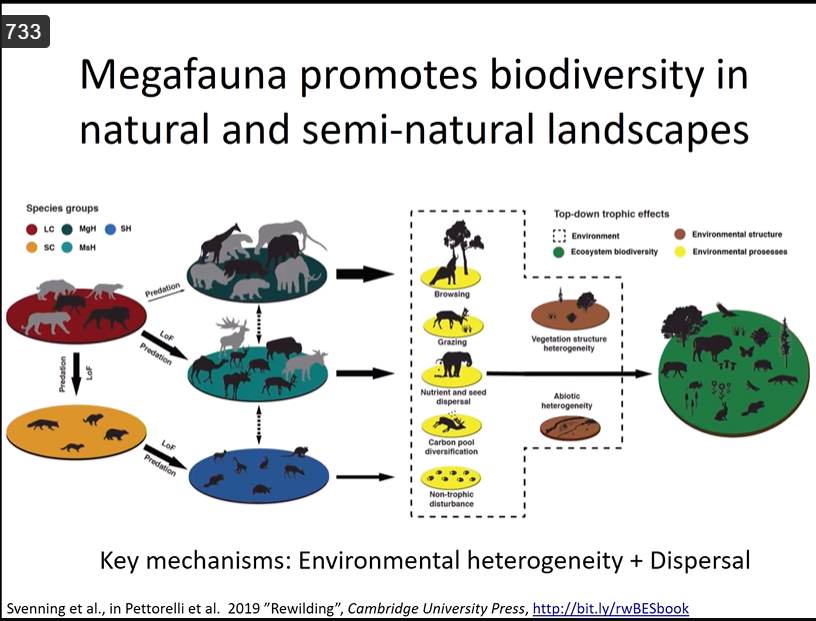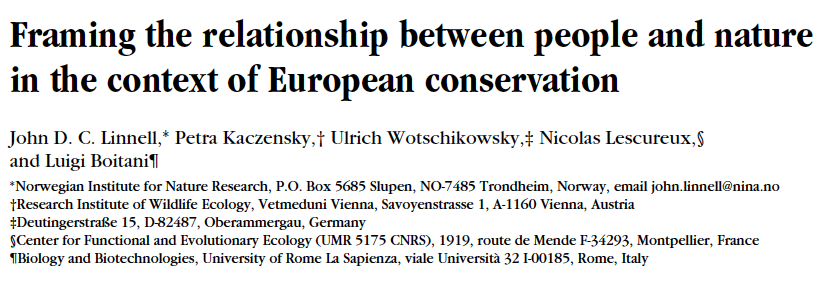
Exploring, and communicating, the science of #rewilding | Tweets by @Nature_Based, @Painting_Nature, @DandoTom, @TrotmanCharlie and @OwenMiiddleton |
How to get URL link on X (Twitter) App


 The authors start by explaining that as animal populations and species decline, the ecological interactions involving them are lost. Trophic rewilding his to restore these interactions through reintroductions or surrogate introductions
The authors start by explaining that as animal populations and species decline, the ecological interactions involving them are lost. Trophic rewilding his to restore these interactions through reintroductions or surrogate introductions 
 Trophic rewilding – use of species to promote trophic cascades and self-regulating ecosystems often involves discussion around megafauna (large bodied species). Their high mobility, resitance to top-down effects, and ability to disperse nutrients makes them ecologically valuable
Trophic rewilding – use of species to promote trophic cascades and self-regulating ecosystems often involves discussion around megafauna (large bodied species). Their high mobility, resitance to top-down effects, and ability to disperse nutrients makes them ecologically valuable

 2/ The Iberá rewilding project is part of the 13,000km2 Iberá Reserve; made up of public & private land. It has marshes, lagoons, small rivers, temporarily flooded grasslands, savannas, and forests. The Conservation Land Trust bought 1500km2 of private land in 1999 to restore.
2/ The Iberá rewilding project is part of the 13,000km2 Iberá Reserve; made up of public & private land. It has marshes, lagoons, small rivers, temporarily flooded grasslands, savannas, and forests. The Conservation Land Trust bought 1500km2 of private land in 1999 to restore. 



 2/ Which historical baseline is used as a reference state is one of the central debates in #rewilding. This can depend on cultural and ecological context of where rewilding takes place….
2/ Which historical baseline is used as a reference state is one of the central debates in #rewilding. This can depend on cultural and ecological context of where rewilding takes place….

 2/ As discussed in previous threads, megafauna have been in a state of decline and extinction since the late Pleistocene. Such large animals would surely have an impact on the environment so what are the consequences of their declines on ecosystem function?
2/ As discussed in previous threads, megafauna have been in a state of decline and extinction since the late Pleistocene. Such large animals would surely have an impact on the environment so what are the consequences of their declines on ecosystem function?

 2/ Since ~2008 the number of rewilding articles has shown a sharp incline, highlighting the growing interest in this ‘radical’ form of ecological management. This challenges existing conservation frameworks…
2/ Since ~2008 the number of rewilding articles has shown a sharp incline, highlighting the growing interest in this ‘radical’ form of ecological management. This challenges existing conservation frameworks… 

 The study analysed remotely sensed data-derived maps in combination with bird census data carried out in 2000 and 2010 at both landscape and census plot scale. 2/9
The study analysed remotely sensed data-derived maps in combination with bird census data carried out in 2000 and 2010 at both landscape and census plot scale. 2/9 

 2/ The use of fire in peatland & heaths is steeped in political, social, and economic debate. Whilst it is difficult and, in some cases, inadvisable to tease-out these points from habitat management, it is important to conduct unbiased ecological assessments for certain practices
2/ The use of fire in peatland & heaths is steeped in political, social, and economic debate. Whilst it is difficult and, in some cases, inadvisable to tease-out these points from habitat management, it is important to conduct unbiased ecological assessments for certain practices

 2/ In the mid-90s, Sergey Zimov founded the Pleistocene park, a 14,000-hectare reserve near Chersky. The intention was to test whether large herbivores, such as, elk moose, reindeer, horses and bison – through grazing - could bring back the mammoth steppe landscape
2/ In the mid-90s, Sergey Zimov founded the Pleistocene park, a 14,000-hectare reserve near Chersky. The intention was to test whether large herbivores, such as, elk moose, reindeer, horses and bison – through grazing - could bring back the mammoth steppe landscape

 2/ Rather than go over last week again, you can check out last weeks thread here
2/ Rather than go over last week again, you can check out last weeks thread here https://twitter.com/RewildingS/status/1296372393703804929

 2/ The author starts by pointing out that the term rewilding has not come from nowhere and that ‘Wilderness’ as a conservation target, particularly in the US, has a long history.
2/ The author starts by pointing out that the term rewilding has not come from nowhere and that ‘Wilderness’ as a conservation target, particularly in the US, has a long history.

 2/20 Articles using the words 'biodiversity' and 'conservation', and using the word 'Anthropocene', separately, increased from 2000 and exponentially so for those with 'Anthropocene' in since ~2005. The two terms have also been increasingly used together in articles since 2011.
2/20 Articles using the words 'biodiversity' and 'conservation', and using the word 'Anthropocene', separately, increased from 2000 and exponentially so for those with 'Anthropocene' in since ~2005. The two terms have also been increasingly used together in articles since 2011. 

 2/21 People value nature in multiple ways which can be broadly categorised into utilitarian, intrinsic, and aesthetic. In other words, the direct benefits nature provide to humans, the inherent characteristics of the landscape, and the attractiveness of an area.
2/21 People value nature in multiple ways which can be broadly categorised into utilitarian, intrinsic, and aesthetic. In other words, the direct benefits nature provide to humans, the inherent characteristics of the landscape, and the attractiveness of an area.

 2/ Cultural landscapes, like those dominated by cork oak are in decline in the Iberian Peninsula due to a shift in usage from traditional maintenance and demographic changes to either agricultural intensification or land abandonment
2/ Cultural landscapes, like those dominated by cork oak are in decline in the Iberian Peninsula due to a shift in usage from traditional maintenance and demographic changes to either agricultural intensification or land abandonment

 2/ Multiple factors including changes in technology, productivity, and markets have led to agricultural abandonment. In Europe cropland has decreased by ~19% from 1950-2010, whilst pastures and semi-natural grasslands have decreased by ~6%
2/ Multiple factors including changes in technology, productivity, and markets have led to agricultural abandonment. In Europe cropland has decreased by ~19% from 1950-2010, whilst pastures and semi-natural grasslands have decreased by ~6%

 2/ “Although there is widespread political and societal support for biodiversity conservation in general, there are considerable disagreements about how to implement it.” E.g. Land Sparing or Sharing? Fence protected areas or Connect them?
2/ “Although there is widespread political and societal support for biodiversity conservation in general, there are considerable disagreements about how to implement it.” E.g. Land Sparing or Sharing? Fence protected areas or Connect them?

 @JCSvenning @PLOSONE 2/ The scene is set by highlighting the dramatic loss of the biggest animals across much of the world in the last ~100,000 years, with evidence suggesting humans were an important cause.
@JCSvenning @PLOSONE 2/ The scene is set by highlighting the dramatic loss of the biggest animals across much of the world in the last ~100,000 years, with evidence suggesting humans were an important cause.

 2/ The papers goal was to investigate the transformation of recent environmental thinking and environmental ethics and in particular the language of “the Anthropocene” which is prominent in driving it.
2/ The papers goal was to investigate the transformation of recent environmental thinking and environmental ethics and in particular the language of “the Anthropocene” which is prominent in driving it.